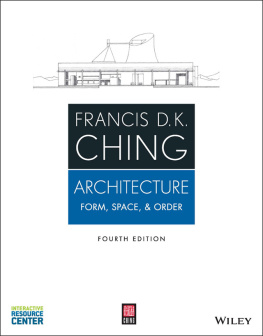

Architecture
Form, Space, & Order
Fourth Edition
Francis D.K. Ching
Copyright 2015 by John Wiley & Sons, Inc. All rights reserved.
Published by John Wiley & Sons, Inc., Hoboken, New Jersey
Published simultaneously in Canada
No part of this publication may be reproduced, stored in a retrieval system, or transmitted in any form or by any means, electronic, mechanical, photocopying, recording, scanning, or otherwise, except as permitted under Section 107 or 108 of the 1976 United States Copyright Act, without either the prior written permission of the Publisher, or authorization through payment of the appropriate per-copy fee to the Copyright Clearance Center, 222 Rosewood Drive, Danvers, MA 01923, (978) 750-8400, fax (978) 646-8600, or on the web at www.copyright.com. Requests to the Publisher for permission should be addressed to the Permissions Department, John Wiley & Sons, Inc., 111 River Street, Hoboken, NJ 07030, (201) 748-6011, fax (201) 748-6008, or online at www.wiley.com/go/permissions.
Limit of Liability/Disclaimer of Warranty: While the publisher and author have used their best efforts in preparing this book, they make no representations or warranties with respect to the accuracy or completeness of the contents of this book and specifically disclaim any implied warranties of merchantability or fitness for a particular purpose. No warranty may be created or extended by sales representatives or written sales materials. The advice and strategies contained herein may not be suitable for your situation. You should consult with a professional where appropriate. Neither the publisher nor the author shall be liable for damages arising herefrom.
For general information about our other products and services, please contact our Customer Care Department within the United States at (800) 762-2974, outside the United States at (317) 572-3993, or fax (317) 572-4002.
Wiley publishes in a variety of print and electronic formats and by print-on-demand. Some material included with standard print versions of this book may not be included in e-books or in print-on-demand. If this book refers to media such as a CD or DVD that is not included in the version you purchased, you may download this material at http://booksupport.wiley.com. For more information about Wiley products, visit www.wiley.com.
A registration code to access the resources included on the Interactive Resource Center is included with every new, print copy of Architecture: Form, Space, and Order, Fourth Edition. If you wish to purchase access to the Interactive Resource Center, you can go to www.wiley.com/go/formspaceorder4e, click on Student Companion Website and then Register, which will allow you to enter a code or to purchase access if you do not have a code. If youve purchased an e-Book version of this title please contact our Customer Care Department:
Customer Care Center - Consumer Accounts
10475 Crosspoint Blvd.
Indianapolis, IN 46256
Phone: (877) 762-2974
Fax: (800) 597-3299
Web: http://support.wiley.com
Library of Congress Cataloging-in-Publication Data:
Ching, Frank, 1943
Architecture : form, space, & order / Francis D.K. Ching. -- Fourth edition.
pages cm
Includes bibliographical references and index.
ISBN 978-1-118-74508-3 (paperback); 978-1-118-74513-7 (ebk); 978-1-118-74519-9 (ebk)
1. Architecture--Composition, proportion, etc. 2. Space (Architecture) I. Title.
NA2760.C46 2014
720.1--dc23
201402021
PREFACE
The original edition of this study introduced the student of architecture to form and space and the principles that guide their ordering in the built environment. Form and space are the critical means of architecture comprising a design vocabulary that is both elemental and timeless. The second edition continued to be a comprehensive primer on the ways form and space are interrelated and organized in the shaping of our environment, and was refined by editing the text and incorporating diagrams for greater clarity, adding selected examples of architectural works, expanding the sections on openings, stairways, and scale, and finally, by including a glossary and an index to designers. The third edition persisted in illustrating the ways the fundamental elements and principles of architectural design manifest themselves over the course of human history but added an electronic component to introduce the aspects of time and movement to the exposition of elements and principles.
In this fourth edition, major changes consist of the addition of more than two dozen contemporary examples, selected to illustrate the new forms that go beyond the timeless elements of basic staticsthe columns, beams, and load-bearing walls of stable constructions that are fixed in time and space. Five more modules have also been added to the electronic component to animate certain design decisions regarding scale and proportion, the type of visual, often subtle judgements that designers face in the development of a project.
The historical models in this book span time and cross cultural boundaries. While the juxtaposition of styles may appear to be abrupt at times, the diverse range of examples is deliberate. The collage is intended to persuade the reader to look for likenesses among seemingly unlike constructions and bring into sharper focus the critical distinctions that reflect the time and place of their making. Readers are encouraged to take note of additional examples encountered or recalled within the context of their individual experiences. As the design elements and principles become more familiar, new connections, relationships, and levels of meaning may be established.
The illustrated examples are neither exhaustive nor necessarily the prototypes for the concepts and principles discussed. Their selection merely serves to illuminate and clarify the formal and spatial ideas being explored. These seminal ideas transcend their historical context and encourage speculation: How might they be analyzed, perceived, and experienced? How might they be transformed into coherent, useful, and meaningful structures of space and enclosure? How might they be reapplied to a range of architectural problems? This manner of presentation attempts to promote a more evocative understanding of the architecture one experiences, the architecture one encounters in literature, and the architecture one imagines while designing.
ACKNOWLEDGMENTS
I will always be indebted to the following people for their invaluable contributions to the original edition of this work: Forrest Wilson, whose insights into the communication of design principles helped clarify the organization of the material, and whose support made its initial publication possible; James Tice, whose knowledge and understanding of architectural history and theory strengthened the development of this study; Norman Crowe, whose diligence and skill in the teaching of architecture encouraged me to pursue this work; Roger Sherwood, whose research into the organizational principles of form fostered the development of the chapter on ordering principles; Daniel Friedman, for his enthusiasm and careful editing of the final copy; Diane Turner and Philip Hamp, for their assistance in researching material for the illustrations; and to the editorial and production staff at Van Nostrand Reinhold, for their exceptional support and service during the making of the first edition.
Next page













